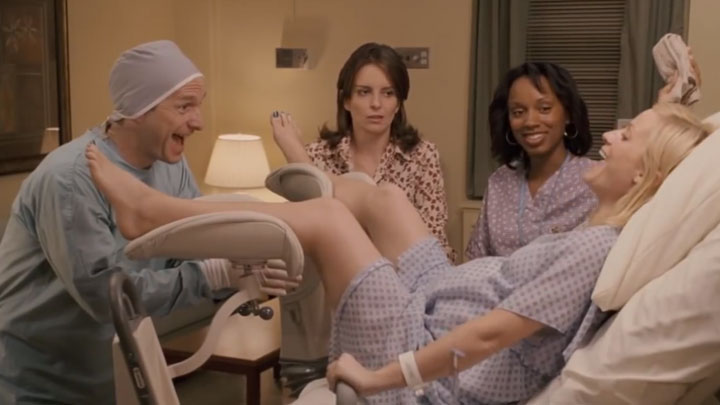
Universal Pictures
1. Your water doesn't break in a ceremonious splatter at your feet. Unlike in every movie ever, when a real woman's water breaks, it usually doesn't look like a water balloon shattering on concrete. More likely, it's going to be a slower, more gradual flow akin to uncontrollably peeing yourself. We've all done that, right?
2. Your water might not break just once. Said "water" — actually, amniotic fluid that forms a protective sac around your baby — can keep trickling all day, necessitating a fat maxi pad, which feels very Are You There God? It's Me, Margaret. This is the first time birth will lead you back to maxi pads. But it ain't the last.
3. If your water doesn't break on its own, a doctor breaks it for you. With a super-long hook-like thingy, I am told. Supposedly it doesn't hurt per se, but just feels "uncomfortable."
4. Just because your water breaks doesn't mean you have to race to the hospital and behave like Hugh Grant in Nine Months. Your water may break but it could still be hours (or even a full day) before contractions start and your cervix begins dilating to make way for le bebe. My water broke in the morning; my husband and I (quite randomly) watched Cops for hours in peace afterward.
5. You can't run around with your water broken or have sex once it does.Just in case in your large, about-to-deliver-a-baby state, you're feeling ripe for the Cosmo Kama Sutra. Because without an amniotic sac protecting him/her, the baby can get an infection. Via your vagina. Within 24 hours of your water breaking, labor will either start on its own or doctors will induce labor with drugs.
6. Contractions may be the worst part. You'd think pushing a baby out would be the absolute worst (given that popular "pushing something the size of a watermelon through something the size of a lemon" analogy). But for many people, contractions are the deepest circle of hell. They start out like regular menstrual cramps and you're all, "Oh, this isn't even that bad!" But they quickly turn into tiny, evil elf hands grabbing your lower back and lower abdomen, and squeezing them with all of their might until pushing out a baby actually seems like a nice change of pace from this bullshit. If you get an epidural because you are sane (JK, I'm sure natural births are awesome but I will NEVER know), contractions may be the most painful part of giving birth.
7. Getting an epidural is like tripping on medically sanctioned ecstasy. It doesn't even hurt at all when the anesthesiologist injects a long needle directly into your spine because he's so amazing, he numbs the area before hooking you up with a totally free (except for your substantial insurance bill) high! The barbaric agony of contractions evaporates within minutes, causing a sweet, sweet numbness in your entire thoracic area. In many cases, your epidural will even come with a handy pump, so you can funnel more painkillers *directly into yourself*! Soon you'll be joyously announcing, "I can't feel my ass!" telling the anesthesiologist you love him, and falling asleep to a My 600-lb Life marathon. But that was just me.
8. You feel like you have to number two. This is gross, but you'll know it's time to start pushing when you feel an intense desire to run to the bathroom and number two. That's because a roughly 8-pound baby has descended into your uterus and is now pressing on your entire nether region, butt included, trying to get out. You may beg the nurses to let you go to the bathroom but you will not be allowed to do so (from what I gleaned, on the off chance you push your baby into the toilet like a 16-year-old at prom in a Lifetime movie?). Anyway, compared to contractions, getting ready to push out the baby is pressure and "discomfort," not stabbing pain, and at this point you really relish the difference. Again, this is if you get an epidural, which, in my opinion, is such a gift from God that pushing a small human being out of your body actually feels do-able.
9. The person who delivers your baby might not be your doctor. In some cases, like mine, your doctor splits hospital rounds with three partners, which means I had a 25 percent chance she would deliver me and a 75 percent chance one of her partners would. I prayed it would be her, because I loved her and I knew her and she massaged a friend "open" so she didn't tear … but alas, she didn't happen to be on call when I got to the hospital, so her partner delivered me. But real talk: If your "real" doctor doesn't deliver you, you sort of don't care anymore. You just want the baby out and whoever is going to help make that happen — her partner, a nurse, a f*cking janitor — seems perfectly acceptable.
10. The doctor may cut "just a snip." This is also known as an episiotomy, which is when the OB/GYN cuts a lady's perineum to help get the baby out. (HORRIBLE MENTAL IMAGE I KNOW, I AM SO SORRY). My OB-GYN friend says this is an antiquated practice and it shouldn't really happen anymore, but it does and the thought of it is horrible and never ever, ever, ever Google "episiotomy." (P.S. Friends of mine who got an epidural did not even feel their episiotomy. Either that or adrenaline acted as a powerful au naturel painkiller.)
11. The doctor may "vacuum" your baby out. My daughter's heart rate was dropping and I had preeclampsia (high blood pressure brought on by labor aka Lady Cybil disease, may she rest in peace), so my doctor used a "vacuum" to suction her out more quickly. He didn't roll a Dyson in to my room to my knowledge, and I couldn't see or feel what was going on, but I was told she was being vacuumed, and she later had a temporary conehead to prove it.
12. If your baby is vacuumed and has a little conehead, you will feel really bad for her and also think it is adorable. Who knew?
13. You have to deliver the placenta. After the main event of getting the baby out you have to deliver the placenta. Someone may casually say "one more push" and it is all very low-key because after birthing a small human, pushing out an amorphic, liver-like thing seems like the ultimate NBD. No, I didn't look at it or encapsulate it or make placenta lasagna with it, like some people have.
14. There will probably be stitches ... Because #10. And even if they didn't, the area might have torn on its own because watermelon-lemon. Epidural and all, I'm sorry to report that I can recall *sort of* feeling post-birth stitches. There is some burning and tugging and the aforementioned "discomfort," but in my case, it was over pretty quickly, and there is an excellent distraction in the mix — your own live baby being weighed, measured, and footprinted like a criminal in your room! (Note: I assume these stitches are not like the rough black stitches I got when I cut my finger open with a serrated bread knife, because those had to be removed by a doctor. Vagina stitches dissolve in a week or so, so let's choose to imagine them like a silky gossamer spun by a master seamstress?)
15. … And blood. This is common sense, you're thinking. Of course there is blood. I can't speak too much to this, because TV episodes like the absurd deer surgery episode of Grey's Anatomy make me squeamish, so I made a point not to look downward too much. But what I could not avoid was a small team of people wadding up blood-soaked medical gown-like papers in my vicinity. Like a lot of them. Everyone is very cordial and tries to keep these out of your line of vision, but you sort of get the idea that this room has turned into a crime scene and people are mopping the floor of your blood ... because, in fact, they are.
16. You'll probably wear a "mommy diaper." A lovely nurse uttered this phrase to me ("Here's your mommy diaper."), and part of my soul died. A mommy diaper is either a maxi pad or an actual diaper packed with ice and tucked into your underwear post-birth to provide some relief. A mommy diaper also doubles as a maxi pad to deal with post-birth bleeding. If you have a dog and they have "wee wee pads," you'll also notice a similar disposable paper pad placed under you and atop your sheets to protect them from blood. Blood blood blood.
17. You essentially have your period for a good six weeks after birth. More maxi pads will be necessary. They've come a long way since you last used pads, like, 20 years ago. But still. Not preferable.
18. A squirt bottle is advised as a handy accessory to toilet paper. Technically called a "peri bottle" — short for perineum irrigation or, in laymen's terms, SQUIRTING WATER ONTO YOUR TAINT, you'll find this plastic bottle in your hospital bathroom and you may choose to use it to squirt warm water onto your intimate areas after going to the bathroom to ensure, what with the stitches and all, that the area is truly clean without having to roughly wipe yourself with toilet paper.
19. All this while, you're not wearing your own underwear. Nor will you go home in them.Instead, you're wearing disposable gauze-like boy shorts (gifted to you by the hospital, so lucky!) that help keep your mommy diaper in place. Also you won't mind if these faux underwear get blood on them, and they maybe-probably will.
20. You will block all of this out roughly three months after birth. Otherwise, who would ever have a second (much less a third) child? When I reminded my BFF, the mom of a 2-year-old, about the peri bottle, she was like, "Ohhh, yeah, I totally forgot about that!" Looking back, birth is like a weirdly realistic dream that you can only vaguely remember or a crazy, adrenaline-fueled dance recital performance in which you blacked out under all of the lights and cheering. What remains is the baby you love so much. Mommy diapers and hospital boys shorts are (thank God) disposable, but this kid is forever.
*Note, these observations are based on birth experiences and anecdotes from friends. Your birth experience could be 10x's more wonderful or more horrible than this.


0 comments:
Post a Comment